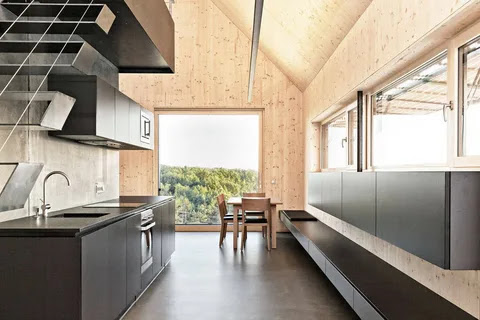CLT An Innovation in Sustainable Building
Ever wondered how that new mid-rise apartment building in your neighborhood got built so quickly? Chances are, it was constructed using an innovative wood product called cross-laminated timber. Cross laminated timber, or CLT, is a solid wood panel made of multiple layers of wood boards stacked in alternating directions and then glued together under high pressure. The result is a strong, durable material that can be used for walls, floors, and roofs in buildings up to 18 stories high. You've probably seen CLT in use and didn't even realize it. This eco-friendly and sustainable building material is revolutionizing construction and allowing architects and builders to create more energy-efficient and visually stunning spaces. Read on to learn all about how CLT is changing the way we build.
What Is Cross-Laminated Timber?
Cross-laminated timber (CLT) is an
innovative wood product that's changing the way we build. What exactly is CLT?
●
CLT is made up of layers of wood
boards stacked in alternating directions, then glued together under high
pressure. This makes CLT panels that are dense, sturdy, and dimensionally stable.
●
The wood layers in CLT can be
locally-sourced softwoods like pine, fir, and spruce. By using fast-growing,
sustainable wood, CLT is an eco-friendly alternative to materials like concrete
and steel.
●
CLT panels can be used as
structural elements in buildings, like walls, floors, and roofs. They are
highly resistant to warping, rotting, and fire. A single CLT panel can replace
numerous steel or concrete members.
●
CLT buildings go up fast. The
panels are prefabricated, so construction is a simple matter of craning the
panels into place and securing them together. This speeds up build times and
reduces costs.
●
CLT provides design flexibility.
The panels can be cut to size for any building. Curved walls, intricate
facades, and open floor plans are all possible with CLT.
In summary, CLT is a versatile,
eco-friendly building material made from sustainable wood sources. It's
revolutionizing construction through its strength, design capabilities, and
efficiency. CLT might just be the future of green buildings.
The Environmental Benefits of Using
CLT
Using CLT in construction is a great
choice for the environment. Here are a few of the major benefits:
●
CLT is made from fast-growing
softwoods like pine, fir, and spruce which are sustainable and renewable. Since
the trees used are typically harvested from working forests, CLT production
supports responsible forestry practices.
●
CLT stores carbon, reducing carbon
emissions. The wood fibers in CLT absorb and lock in carbon dioxide from the
atmosphere. In fact, 1 cubic meter of CLT contains roughly 1 ton of stored
carbon.
●
CLT is highly energy efficient.
The wood fibers provide natural insulation, reducing heating and cooling
demands in CLT buildings. The modular panels also allow for tight construction,
minimizing drafts.
●
CLT is reusable and recyclable.
The panels can be disassembled and reassembled at a new location with no waste.
They can also be recycled into other wood products at the end of their
lifespan.
●
CLT reduces construction waste.
The precision manufacturing process minimizes excess wood material. Any
leftovers can also be recycled.
Using CLT helps ensure that the buildings
we construct today don't compromise the environment for future generations.
It's an eco-friendly solution that promotes sustainable forestry and reduces
pollution from emissions. Not to mention, the natural beauty of wood creates
spaces that feel warm and inviting. Overall, CLT is a win for the planet and
our well-being.
Innovative Applications of CLT in
Modern Buildings
Modern Architectural Marvels
Cross-laminated timber (CLT) has enabled
innovative new building designs that were nearly impossible with concrete and
steel. Architects are pushing the boundaries of CLT’s strength and flexibility
to create eco-friendly structures that are also architectural wonders.
The Brock Commons Tallwood House at the
University of British Columbia is a student residence building that holds the
record for the tallest modern timber building in the world at 18 stories high.
The wooden structure demonstrates how CLT can be used to build mid-rise and
high-rise buildings in a sustainable way.
The Origine apartment complex in Quebec,
Canada showcases CLT’s esthetic appeal with its wood-clad exterior and exposed
timber ceilings and staircases in the interior. The wood provides warmth and
natural beauty to the living spaces. The CLT panels were also prefabricated to
speed up construction and reduce waste.
CLT allows for more innovative shapes
that concrete cannot easily achieve. The Wood Innovation and Design Center in
British Columbia has an undulating wooden roof structure made of CLT. The
coil-shaped design is a visually striking and complex geometric form that was
made possible through CLT manufacturing techniques like precision cutting and
lamination.
Eco-friendly building materials like CLT
will transform skylines with sustainable yet stunning new architectural forms.
CLT’s strength, versatility, and prefabrication abilities are enabling creative
new building shapes and styles that push the boundaries of modern timber construction.
The opportunities for innovative CLT
design applications are endless.
Conclusion
So there you have it. Cross Laminated
Timber is an innovative building material that offers a sustainable, durable,
and esthetically pleasing alternative to conventional building materials like
concrete and steel. The next time you see a modern wood building going up in
your city or neighborhood, you'll know that it's not just a stylish facade -
it's an environmentally-friendly structure built to last. While CLT may still
be relatively new to North America, it's gaining ground and popularity fast. As
architects, builders, and homeowners realize the benefits of CLT, it's likely to
become a staple in green buildings and eco-friendly architecture. The future is
wooden, my friend. And the future is bright.




Comments
Post a Comment